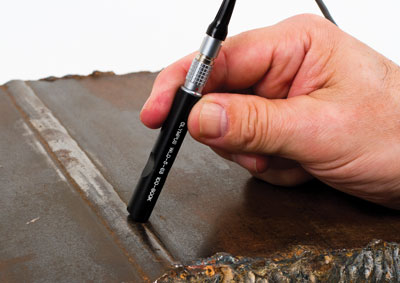Eddy Current Weld Inspection

Image - eddy-current-weld-inspection
- NDT Method
Eddy Current Testing - Application Category
Weld Inspection
Eddy Current Non Destructive Testing is a reliable, quick and inexpensive way to carry out preventative maintenance and ensure safety. Eddy current is good for detecting surface-breaking defects, can detect these defects through fairly thick coatings (up to 2 mm), and can be used on wet surfaces (even underwater), but several scans of an individual weld must be performed to ensure a defect is not missed. Eddy current is also an operator-dependent technique.
There are many practical applications of weld inspection using eddy current techniques. These include the following:
Offshore structures
Offshore structures such as drilling platforms are subjected to cyclical loads twice daily (tides) and, more unpredictably, by severe weather. Fatigue crack propagation can occur topside or underwater and periodic inspection of critical weld areas is required. Frequently, topside inspections are only possible by rope access. Underwater inspections and repairs are often done by divers at acceptable depths and in acceptable water environments.
Bridges, cranes, traffic signals
All these structures are subject to cyclical loading on their welded structures, as well as weather-related loading and weight loading in cranes and bridges. Cantilevered traffic arms are a relatively recent application that has resulted from the failure of such arms because of weather-induced weld fatigue. Such failures have had fatal results.
Ships & Submarines
Ships are subject to bending and torsional moments in day-to-day use. Extreme weather conditions, shifting loads, and grounding can lead to extreme loading of the superstructure and overstress critical welded joints. Submarines are subject to the same loading as surface ships plus have the added stress of the cyclical loading that accompanies pressure changes associated with submerged operations.
Amusement park rides
Another relatively recent application is the inspection of amusement park rides. Again, these rides are subject to the same cyclical loading as bridges and cranes. Due to public demand, theme parks in warmer climates are often required to be in operation 364 days a year. Every day a ride is unavailable due to maintenance closure a negative public reaction is encountered, even if the closure is for safety-critical inspection and maintenance. Eddy current techniques for the inspection of track and cars represent a significant reduction in manpower and downtime, resulting in more cost-effective and higher quality maintenance and inspection along with more paying hours of operational attractions.
Articles related to Weld Inspection
Talk to us Now !
We offer the best and most affordable NDT services in the market.
